
Original Link: https://www.anandtech.com/show/5730/antec-eleven-hundred-the-p280s-gloves-come-off
Antec Eleven Hundred: The P280's Gloves Come Off
by Dustin Sklavos on April 9, 2012 12:00 AM EST- Posted in
- Antec
- Cases/Cooling/PSUs
- mid-tower
Introducing the Antec Eleven Hundred
Towards the end of last year, I took a visit out to Antec's campus in Fremont to see two new cases: the headlining P280, and the shortly-to-follow Eleven Hundred. The P280 we've already reviewed; it's as much a complement to the existing P180 series as it is a refresh, but our review of the Eleven Hundred has been conspicuously absent since its launch. That's due to a combination of bad timing and the fact that, superficially, the Eleven Hundred has an awful lot in common with the P280, pushing other cases to the front of the line.
.jpg)
With the refreshed case testbed I decided it was time to take a look at the Eleven Hundred, if for no other reason than to at least get a comparison point that was similar to the P280 in our results. As it turns out, though the Eleven Hundred shares the same fundamental framework and chassis as the P280, the differences between the two are far more notable than they seem.
The chassis used as the foundation of the Eleven Hundred is identical to the one the P280 enjoys (including the fan power hub in the back), but the side, top, and front panels are all different, as is the stock cooling configuration. The result is an enclosure that looks similar in many ways, but has a few different strengths and weaknesses, and most definitely performs differently.
| Antec Eleven Hundred Specifications | ||
| Motherboard Form Factor | ATX, Micro ATX | |
| Drive Bays | External | 3x 5.25” |
| Internal | 2x 2.5"/6x 3.5" | |
| Cooling | Front | 4x 120mm intake (two in front of the drive cage and two internal) |
| Rear | 1x 120mm exhaust | |
| Top | 1x 200mm blue LED exhaust | |
| Side | 3x 120mm fan mounts (one behind the motherboard tray) | |
| Bottom | - | |
| Expansion Slots | 9 | |
| Front I/O Port | 2x USB 3.0 (via motherboard header), 2x USB 2.0, 1x Headphone, 1x Mic | |
| Power Supply Size | Standard ATX | |
| Clearances | HSF | 180mm |
| PSU | 300mm | |
| GPU | 13" / 330mm | |
| Weight |
15.3 lbs. 6.9 kg |
|
| Dimensions |
20.7" x 9.3" x 21.5" 527mm x 237mm x 546mm |
|
| Special Features |
Silicone grommets for side fans USB 3.0 via motherboard header Internal fan mounts Toolless SSD installation Fan mount behind motherboard tray Molex-powered internal fan hub |
|
| Price | $100 | |
If you go back and pore through our Antec P280 review, a lot of what you'll see with the Eleven Hundred will look very familiar. Specs are almost identical, but what's interesting is that the Eleven Hundred removes the option to mount a 240mm radiator to the top of the enclosure that the P280 has, instead replacing it with a massive 200mm exhaust fan. The fan control switches in the back are gone, too; the opening is still there since the Eleven Hundred uses the same basic chassis as the P280, but instead there's just a single switch to toggle the blue LED for the fan. The conclusion these elements (and more) lead up to is that though they share a chassis, the P280 was engineered for acoustics while the Eleven Hundred was engineered for performance.
In and Around the Antec Eleven Hundred
It doesn't make too much sense to keep belaboring the comparison between Antec's P280 and the Eleven Hundred because as I discovered in the process of working on this review, there are some major differences between the two. The front bezel of the Eleven Hundred is almost completely ventilated, and that includes the shields for the 5.25" drive bays. It's actually a bit surprising that Antec didn't include any front-mounted intake fans, but given the basically wide-open-but-not-really design of the fascia coupled with the massive 200mm exhaust fan in the top of the enclosure, the Eleven Hundred may simply not need them in its default configuration.
.jpg)
One of the elements I especially like about the Eleven Hundred is the I/O port and button placement: the ports along the top front of the face and the power button and reset button on the front of the top of the enclosure show that Antec understands and expects the case to be placed on the floor, but doesn't force you to pick a side for you to set it. When you do get to the top, you'll see that 200mm exhaust fan. It glows bright blue, but thankfully the LEDs can be toggled off depending on your taste.
.jpg)
The side panels are fairly interesting. On the left side, Antec includes a window, pegs, and silicone grommets for mounting a pair of 120mm fans laterally. These intakes are lined up pretty specifically with where you can expect multiple graphics cards to be, and there's no side intake for the CPU cooling. Instead, there's a spacious panel behind the motherboard tray that's slightly bowed out to make it easier to route cables, but also a 120mm fan mount designed to intake cool air against the back of the CPU socket.
.jpg)
Both side panels are mounted using thumbscrews, and they're hinged rather than needing to be lined up and slid onto the chassis, making it much easier for the end user to close up shop. Removing them reveals the interior of the Eleven Hundred, which features the usual rubber-lined cable routing holes around the motherboard tray along with a sizable cutout for heatsink mounting brackets. The drive cage features six mounts for 3.5" drives (using rails included with the enclosure that snap into the drive's sides securely) and two toolless mounts for 2.5" drives. There are also four internal 120mm fan mounts; two are in the front of the enclosure (the front fascia is easy to snap on and off) while two are actually inside the case, behind the drive cage.
All told, I personally find the aesthetic of the Eleven Hundred to be a lot tamer than many of the other gaming cases Antec sells. I liked how the P280 looked, and even though the Eleven Hundred is much tarted up, it's still not the plastic-and-LED "gamer-oriented" design the Six Hundred and Nine Hundred series have. Internally, it looks relatively easy to assemble, too, and certainly spacious enough without outright wasting real estate.
Assembling the Antec Eleven Hundred
Though it may share the DNA of Antec's Performance series, the Eleven Hundred is thankfully far easier to assemble than many of its predecessors were. Antec's engineers took care to make sure the Eleven Hundred was easy to work in, and by and large they were successful.
The motherboard tray comes with standoffs preinstalled, but not so tightly that they were impossible to remove and move around for our Micro-ATX test board. Our I/O shield also snapped easily into place, and the board took just the right amount of pressure to line up and install.
Just about every peripheral and other component was easy to install, too. The optical drive is installed by first popping off the front fascia of the Eleven Hundred (easier done than said), then twisting out the metal place holder. Apply a healthy amount of pressure, and the optical drive will pop into the toolless mechanism and lock into place with very little wobble (the wobble-wary can also use screws to secure the optical drive). 3.5" drives are just as easy; the rails Antec uses snap into the sides of 3.5" drives. These rails are simple to install and remove despite being remarkably secure while in place. Finally, 2.5" drives slide into a dedicated cage just above the 3.5" drive cage. They're secure enough there, but I'd probably think twice about using a mechanical drive; this cage was clearly designed for SSDs with no moving parts, as there's definitely some wiggle room.
Expansion cards are installed by removing thumbscrews and ventilated expansion bay covers; slot the card in, then replace the thumbscrews. Finally, the power supply is bottom-mounted and as long as you use a unit that's 180mm or shorter, there's access to a hole in the tray for routing cables behind the motherboard.
It's mostly very easy to route cables in the Eleven Hundred, but the 2.5" drive cage design continues to be somewhat problematic. Simply put, the back of the drive isn't deep enough and the cage design isn't secure enough to make cabling the 2.5" drives as easy as everything else is. This is probably the only black mark on the cabling design of the Eleven Hundred; the case fans get plugged into a molex-powered hub that has four three-pin headers on it. There are a few gripes I could make about the hub, but it's nonetheless a convenience that I appreciate. I just wish four-pin molex would die already; would it be that much harder to replace this with a SATA power lead?
All told, though, complete assembly of the Eleven Hundred is very easy and probably the equal of any Corsair enclosure in that regard. This might actually make a good beginner enclosure, as it's pretty simple to put together but has some room for a burgeoning enthusiast to experiment with assembly. My only real complaint is that you can't mount a 240mm radiator to the top of the enclosure; theoretically you could put one in the interior front or even on the left side panel, but not in its usual home. I don't see this being a major issue for most users, but it's worth pointing out.
Testing Methodology
For testing Micro-ATX and full ATX cases, we use the following standardized testbed in stock and overclocked configurations to get a feel for how well the case handles heat and noise.
| ATX Test Configuration | |
| CPU |
Intel Core i7-2700K (95W TDP, tested at stock speed and overclocked to 4.3GHz @ 1.38V) |
| Motherboard | Gigabyte GA-Z68MX-UD2H-B3 |
| Graphics Card |
ASUS GeForce GTX 560 Ti DCII TOP (tested at stock speed and overclocked to 1GHz/overvolted to 1.13V) |
| Memory | 2x2GB Crucial Ballistix Smart Tracer DDR3-1600 |
| Drives |
Kingston SSDNow V+ 100 64GB SSD Samsung 5.25" BD-ROM/DVDRW Drive |
| Accessories | Corsair Link |
| CPU Cooler | Cooler Master Hyper 212 Evo with Cooler Master ThermalFusion 400 |
| Power Supply | SilverStone Strider Plus 750W 80 Plus Silver |
Each case is tested in a stock configuration and an overclocked configuration that generates substantially more heat (and thus may produce more noise). The system is powered on and left idle for fifteen minutes, the thermal and acoustic results recorded, and then stressed by running seven threads in Prime95 (in-place large FFTs) on the CPU and OC Scanner (maximum load) on the GPU. At the end of fiteen minutes, thermal and acoustic results are recorded. This is done for the stock settings and for the overclock, and if the enclosure has a fan controller, these tests are repeated for each setting. Ambient temperature is also measured after the fifteen idle minutes but before the stress test and used to calculate the final reported results.
Thank You!
Before moving on, we'd like to thank the following vendors for providing us with the hardware used in our testbed.
- Thank you to Puget Systems for providing us with the Intel Core i7-2700K.
- Thank you to Gigabyte for providing us with the GA-Z68MX-UD2H-B3 motherboard.
- Thank you to Crucial for providing us with the Ballistix Smart Tracer memory.
- Thank you to Corsair for providing us with the Corsair Link kit.
- Thank you to Cooler Master for providing us with the Hyper 212 Evo heatsink and fan unit.
- Thank you to Kingston for providing us with the SSDNow V+ 100 SSD.
- Thank you to CyberPower for providing us with the Samsung BD-ROM/DVD+/-RW drive.
- And thank you to SilverStone for providing us with the power supply.
Noise and Thermal Testing, Stock
Admittedly with only one comparison point, and that point being about $40 more expensive, the results here are going to be a bit unusual. The Antec Eleven Hundred was clearly designed for performance first and acoustics second, while the Corsair Obsidian 550D's priorities are the other way around. Still, our testbed was refreshed only recently, and we're looking forward to adding more results over time. So while the Obsidian 550D is going to be a potentially interesting comparison point, what we're really looking to ascertain is how much headroom the Eleven Hundred has to work with.
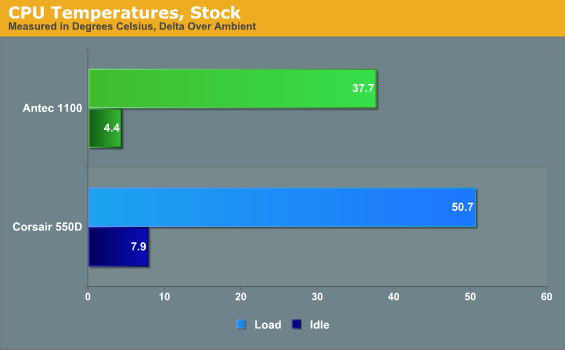
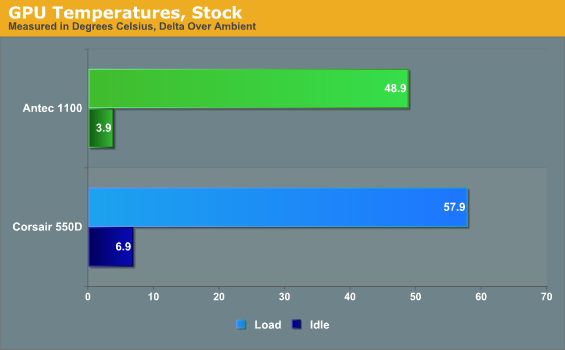
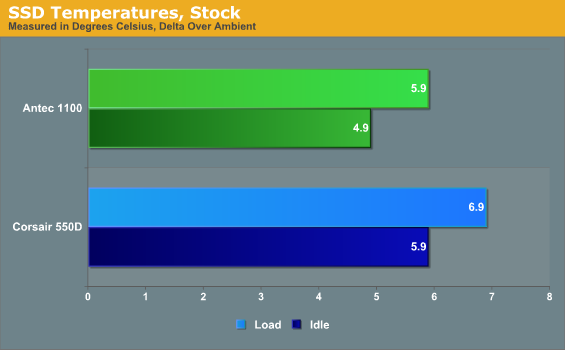
Thermally, the Eleven Hundred puts in a relatively strong showing when taken on its own merits. While we can't strictly compare it to the cases we've previously tested, I can tell you these results are more on the low side. It's taken a while to break my habit of assuming a negative pressure cooling system is inherently "bad," but enclosures like the Eleven Hundred can justify it. With so much ventilation, the Eleven Hundred doesn't have a very hard time getting fresh air in.
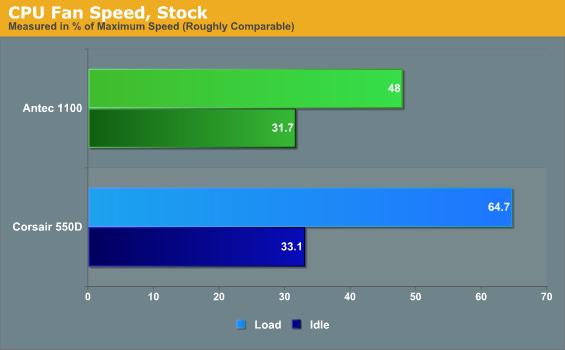
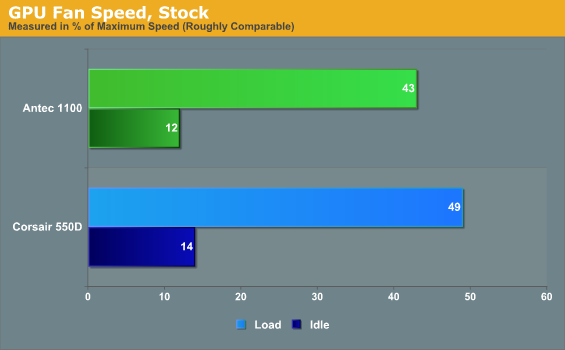
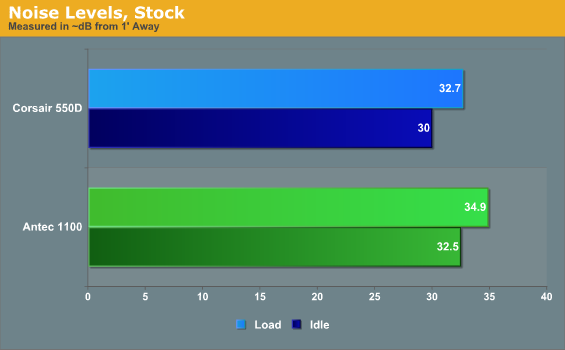
Remarkably the Eleven Hundred isn't particularly loud at stock settings, either, but you'll notice the fans also don't have to work anywhere near as hard as they would in a much more enclosed case like the 550D. This is an important thing to note when you're talking about the balancing act between acoustics and performance; if an enclosure channels air well enough, the fans don't have to work as hard, and thus remain quieter.
Noise and Thermal Testing, Overclocked
The Antec Eleven Hundred put in a strong showing with our stock settings, clearly offering a substantial amount of thermal headroom right from the factory. Hopefully the more open-air design will continue to pay dividends once we jack up the voltage on the CPU and the graphics card and overclock them both.
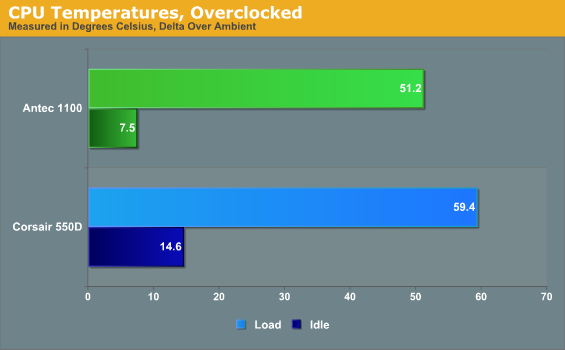
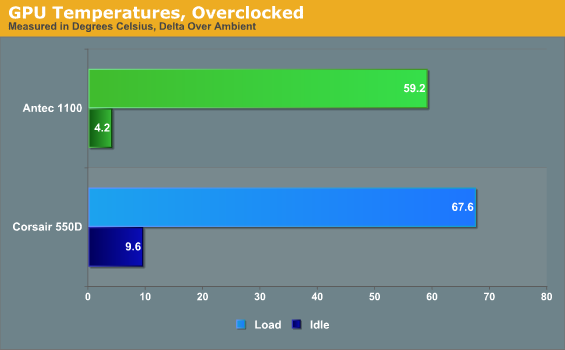
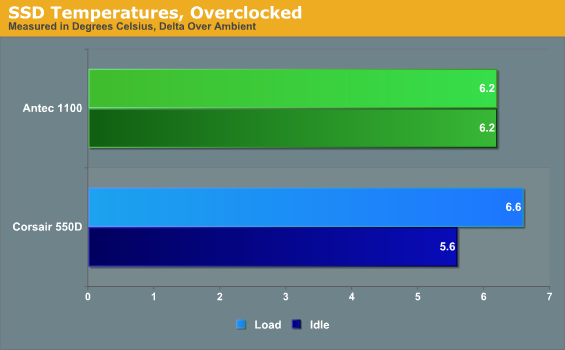
Antec's enclosure separates a lot more from Corsair's acoustically-oriented design once overclocks are applied, as the major components run much cooler at both idle and load. That's to be expected; the Eleven Hundred already proved it had plenty of thermal headroom and even here that continues. Ambient temperatures during testing hovered around 23C; if you do the math, even in a room that's pushing 90 degrees Fahrenheit (32C), the Eleven Hundred should still keep the components running well below spec temperature.
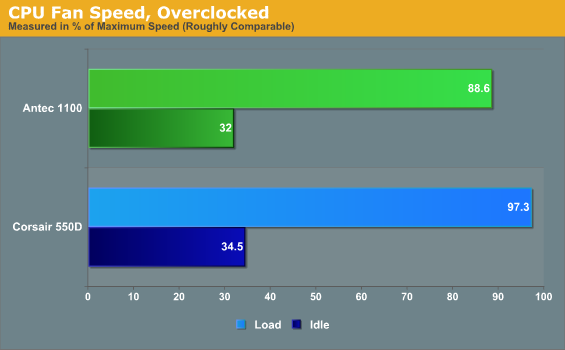
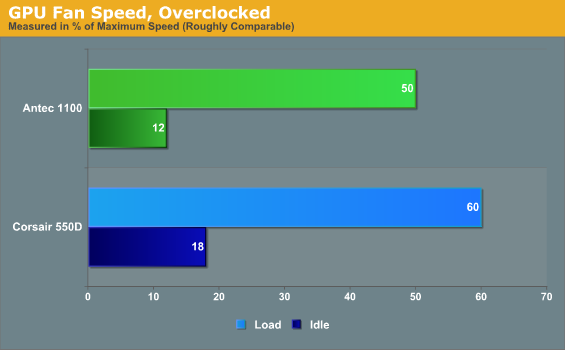
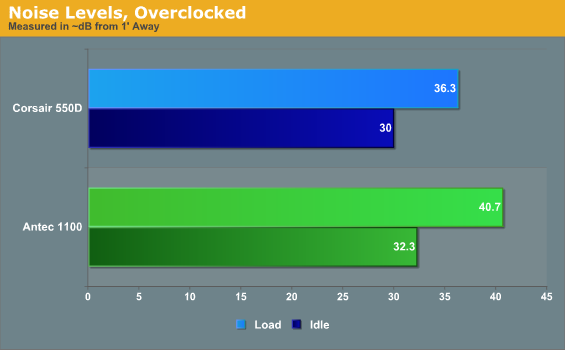
That headroom is borne out again when we look at fan speeds; while the Corsair 550D's more closed-off design results in our cooling system beginning to hit its limits, the Antec Eleven Hundred still has a bit more to go.
I don't intend to denigrate the 550D's thermal performance, though, because when you take a look at our noise levels you see where the 550D's strengths lie. The Eleven Hundred becomes very noticeable when stressed while the 550D does a better job of keeping a lid on the parts. Those fans may be working harder, but they're still ultimately working quieter in Corsair's case. This is the tradeoff users routinely have to make if they're not willing to spend up on something beefier like SilverStone's FT02 or Cooler Master's Cosmos II.
Conclusion: Solid Midrange, Solid Beginner
If you'll let me beat this dead horse one last time, I'm keen to point out what the Antec Eleven Hundred isn't: a cheaper P280. Just because it shares the same internal framework, that doesn't mean it's the same case. That was the mistake I made when I began the review before testing proved me wrong. What I wanted was something similar to the P280 to use as a comparison point to the 550D, and what I got was something entirely different.
So now that we've established what the Eleven Hundred isn't, we can talk about what it is: a very compelling midrange option for users who prioritize thermal performance over acoustics. The Eleven Hundred has virtually no allowances made for keeping quiet; it's all about moving cool air over hot components, and at that it does very well. With so few data points currently available it's tough to gauge just how strong a performer it is compared to the rest of the market, but speculatively I think it's going to continue putting in a strong showing as we add more results to the new testbed.
Even without those results in hand, it's clear the Eleven Hundred has thermal headroom well beyond what we tested it at. Remember that this is with the stock fan configuration; there's still plenty of room for the more enterprising user to expand and improve the Eleven Hundred's cooling potential. That's what makes it easy to recommend on the performance front: we've seen it perform well with enthusiast-grade thermals and we know it has room to grow.
At the same time, assembly is very easy, making the Eleven Hundred an excellent option for neophytes and veterans alike. If you've never built a computer before, this case is a good one to start building and playing in. If you've built ten or a hundred computers, you'll appreciate how easy it is to work inside the Eleven Hundred. And in either instance and all points in between, you're getting a case that keeps components cool. In a more basic, stock build as opposed to an enthusiast-geared one, you're also getting a case that's able to run fairly quietly due almost entirely to the solid thermal performance.
I'm hesitant to sing the Eleven Hundred's praises from the rooftops yet, but as it stands, Antec has produced another quality case that I would happily recommend to users who are less concerned with quiet than they are with flexibility.

_thumb.jpg)
_thumb.jpg)
_thumb.jpg)
_thumb.jpg)
_thumb.jpg)
_thumb.jpg)
_575px.jpg)
_575px.jpg)
_575px.jpg)
_thumb.jpg)
_thumb.jpg)
_thumb.jpg)
_thumb.jpg)
_thumb.jpg)
_thumb.jpg)






